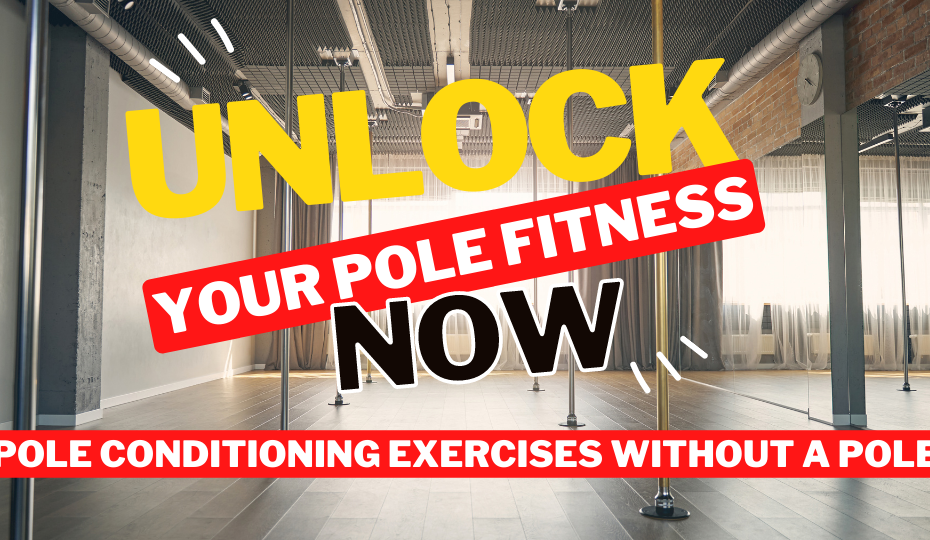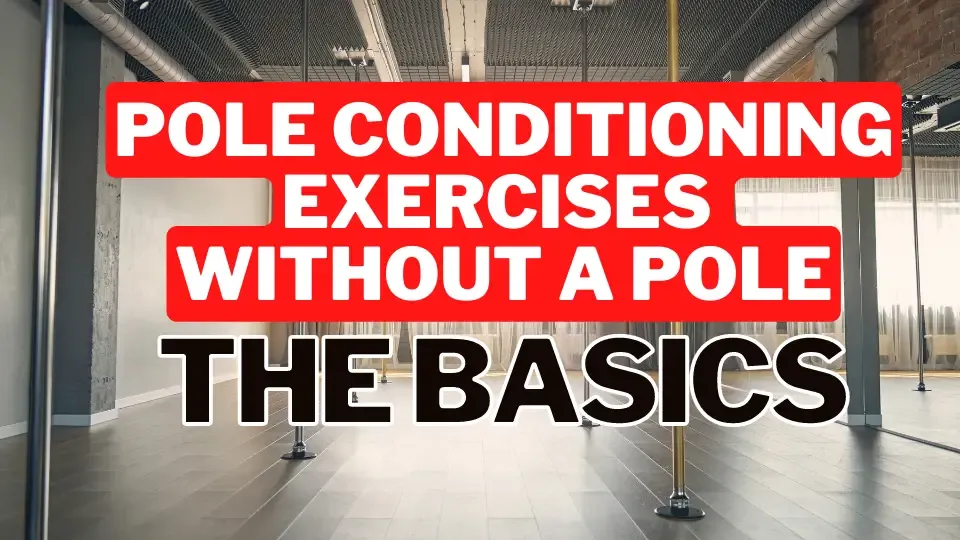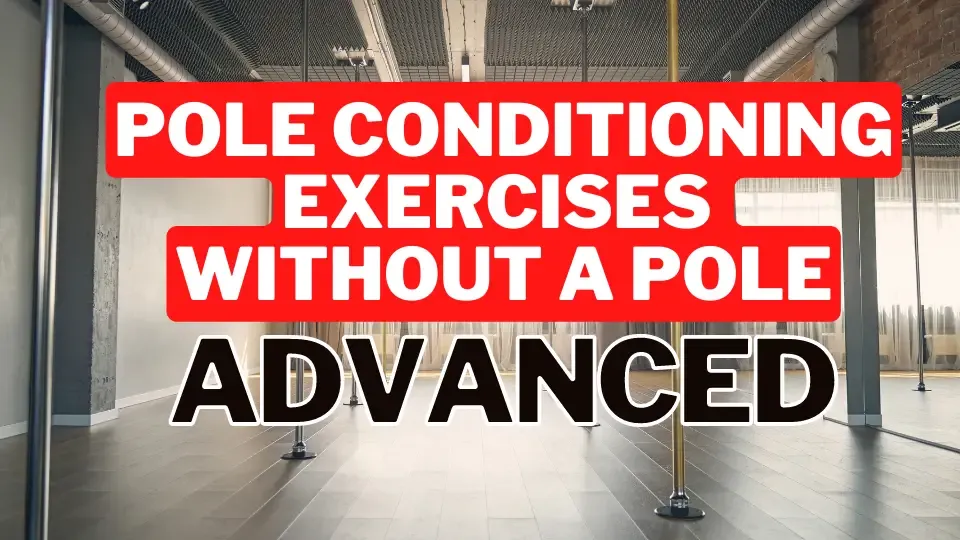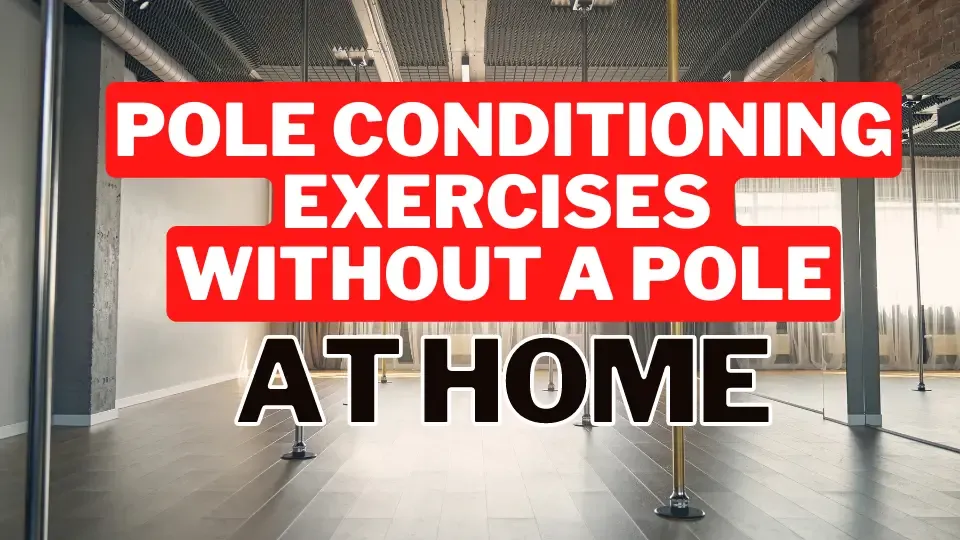· Home Pole Dance · Pole Dancing · 13 min read
Unlock Your Pole Fitness NOW: Essential Pole Conditioning Exercises Without a Pole
There's no denying it, I am head over heels for pole dancing and pole fitness. It's an exhilarating, empowering form of exercise that leaves me feeling stronger, more flexible, and brimming with confidence after each session.

There’s no denying it, I am head over heels for pole dancing and pole fitness. It’s an exhilarating, empowering form of exercise that leaves me feeling stronger, more flexible, and brimming with confidence after each session. But what if you find yourself in a situation where you can’t access a pole? Traveling, limited studio availability, or simply not owning a pole can make practicing seem impossible. But fear not, because there’s a world of pole conditioning exercises without a pole that we can tap into!
These workouts are an essential part of pole dancing, even when you have a pole at your disposal. They build the core strength, flexibility, and balance necessary for the sport, making them excellent home workouts for pole dancers or anyone seeking an unconventional fitness routine. It’s also a fantastic way for beginners to get a taste of the sport without the initial investment of a pole.
Pole conditioning exercises without a pole are a unique mix of cardio, strength training, and flexibility exercises, which makes them ideal for fitness enthusiasts of all kinds, not just aspiring pole dancers. They provide an exciting twist to traditional workouts, helping to break the monotony of regular fitness routines.
In the following sections, we’ll dive into some of these workouts, discussing their benefits and how to do them right, all aimed at getting you fit and ready for the pole - even without one! Welcome to this beginner’s guide to pole fitness without a pole, where we turn limitations into opportunities for growth and strength.
Also read Muscles Used In Pole Dancing
Key Takeaways
- 💪 Home Pole Dance explains the importance of pole conditioning exercises without a pole, citing benefits like building strength, flexibility, coordination, and breaking the monotony of regular workouts.
- 📚 The page provides a comprehensive guide to basic and advanced pole conditioning exercises that can be carried out without a pole, covering everything from push-ups to flexibility training.
- 🏠 Suggestions are given for implementing a pole conditioning routine at home, emphasizing the importance of consistency, setting realistic goals, and maintaining motivation.
- 🔄 While pole dancing involves using a pole, preparing for pole fitness doesn’t have to stop due to inaccessible poles. In fact, pole conditioning exercises without a pole help enhance overall fitness while preparing for pole dancing.
- 💃 The journey to mastering pole dancing starts with strength, flexibility, and coordination but it’s not just about the destination, it’s also about appreciating your body’s capabilities, progress and enjoying the process.
Also read Can You Pole Dance With Sweaty Palms
Why Pole Conditioning Exercises Without a Pole Are Essential
Pole dancing is a full-body workout that demands strength, flexibility, and coordination, and pole conditioning exercises, particularly those you can do without a pole, are the stepping-stones to mastering these elements.
Importance of Strength for Pole Dancing
Many look at the mesmerizing spins and lifts in pole dancing and see a dance form. But as I’ve come to know, it’s also a true test of strength. Every move calls for muscle control that stems from core strength. Holding your body on the pole, inverting, and performing advanced moves requires considerable power, particularly in your upper body and core.
Pole conditioning exercises without a pole focus on developing this muscle power. Think of exercises like planks, push-ups, and squats. These workouts, done without the need for a pole, help build the necessary strength to perform pole dancing moves. Incorporating these into your fitness routine can prepare your body for the demands of pole dancing, even when a pole is not accessible.
Role of Flexibility in Pole Fitness
While strength forms the foundation of pole fitness, flexibility adds the grace and fluidity to the movements. Without flexibility, many of the poses and transitions in pole dancing are impossible to perform. Flexibility training, especially as part of pole conditioning exercises without a pole, often includes stretches and yoga poses that increase your range of motion, making your future moves on the pole more fluid and refined.
Coordination: The Key to Mastery
The beauty of pole dancing is not just in the power and flexibility it demonstrates, but also the coordination and body awareness it requires. Pole conditioning exercises without a pole aim to develop this mind-muscle connection. It’s a skill that’s essential in safely executing pole moves and transitioning between them smoothly. It’s also a transferable skill that enhances other fitness activities and even daily life tasks.
Thus, pole conditioning exercises without a pole have a dual benefit. They prepare you for pole dancing by developing the necessary strength, flexibility, and coordination. And they provide a comprehensive workout regime that enhances your overall fitness, irrespective of whether you intend to venture into pole dancing or not. That’s what makes them a valuable addition to any fitness enthusiast’s routine.
Also read 40mm Vs 45mm Vs 50mm Dance Poles
Pole Conditioning Exercises Without a Pole: The Basics

You might be wondering, “Without a pole, how can I prepare for pole dancing?” The good news is there’s a host of exercises you can do right at home that closely mimic the physical requirements of pole dancing. These range from bodyweight exercises that enhance your strength to core workouts that build stability and control.
Bodyweight Exercises for Pole Dancers
Bodyweight exercises are a fundamental part of any pole dancer’s conditioning routine. These exercises use your body’s weight as resistance to build strength and endurance, especially in your upper body and core. You’ll be surprised to know how closely these exercises can replicate the muscle engagement of pole dancing.
- Push-ups: Push-ups target your upper body, strengthening the chest, shoulder, and arm muscles crucial for holding yourself on the pole.
- Tricep dips: Tricep dips build arm and shoulder strength. Use a sturdy chair or bench to perform this exercise.
- Squats and lunges: Lower body strength is equally important in pole dancing. Squats and lunges help develop leg and glute muscles, which add power to your pole lifts and spins.
- Pull-ups: If you have access to a pull-up bar, this exercise is an excellent way to train your upper body and mimic the muscle engagement needed to lift your body weight on the pole.
- Burpees: Burpees are a comprehensive exercise that targets multiple muscle groups, making them an ideal conditioning exercise for pole dancing.
Core Strength for Pole Dancing
The core is the powerhouse of pole dancers, providing stability and control for almost every move. Core strength for pole dancing is therefore non-negotiable, and there’s a myriad of exercises you can do without a pole.
- Planks: The humble plank is a fantastic exercise for building core strength. You can play around with variations like side planks and forearm planks to target different muscles.
- Russian twists: This exercise targets your obliques, helping to build the rotational strength needed for many pole moves.
- Leg raises: Laying on your back and raising your legs targets the lower abs, enhancing your control in lifts and inversions.
- Bicycle crunches: These work your entire core, promoting strength and stability for complex pole maneuvers.
These preparatory workouts for pole fitness are just the tip of the iceberg. They form a solid foundation for your pole journey, getting you one step closer to your pole goals, even without a pole in sight. Start incorporating them into your fitness routine, and you’ll be ready to hit the pole running (or spinning!) when the opportunity presents itself.
Also read Do Stripper Poles Spin
Advanced Pole Conditioning Exercises Without a Pole

While the basic exercises prepare you for the physical demands of pole dancing, advanced flexibility and mobility exercises will truly help elevate your performance. Even if you’re already involved in pole dancing or an experienced fitness enthusiast, these exercises are key for continued progress and prevention of injuries.
Flexibility Training for Pole Dance
Advanced flexibility training involves going beyond the simple stretches to include dynamic and static stretching, as well as deep stretching techniques that increase your range of motion. This increased flexibility will enable you to achieve more complex moves and transitions in pole dancing.
- Split stretches: Splits are an iconic part of pole dance routines. Training for splits involves a series of stretches that target your hamstrings, hip flexors, and glutes.
- Backbends: Backbends help improve the flexibility of your spine, which is essential for many pole moves. Always warm up properly before practicing backbends, and listen to your body’s signals to avoid injury.
- Shoulder and chest openers: These stretches, often borrowed from yoga, improve your upper body flexibility, making it easier to achieve various arm and shoulder positions on the pole.
- Dynamic stretching: Dynamic stretching involves movement and can be done as part of your warm-up routine. Examples include leg swings, arm circles, and torso twists.
Mobility Exercisesfor Pole Dancers
Mobility exercises help to improve your body’s ability to perform smooth, controlled movements, which is essential for pole dancing. These exercises often involve active stretching and strength exercises that challenge your range of motion.
- Hip mobility drills: Hip mobility is crucial for pole dancers for moves like the straddle and butterfly. Drills may include leg swings, hip circles, and froggy stretches.
- Shoulder mobility drills: Shoulder mobility exercises such as wall slides, shoulder rotations, and scapular shrugs can enhance your shoulder range of motion and stability.
- Ankle mobility drills: Ankle strength and mobility are often overlooked in pole fitness but are key for balance and control in many moves.
- Wrist mobility drills: Wrist mobility is essential given the grip and weight-bearing nature of pole dancing. Wrist circles, stretches, and strengthening exercises can help prepare your wrists for the demands of pole dance.
Including these flexibility and mobility exercises in your conditioning routine will greatly enhance your performance on the pole, and also translate to improvements in other fitness activities. Remember that advanced conditioning exercises for pole dancing are not about how far you can stretch or how many exercises you can do, but about consistent, controlled practice that improves your body’s performance over time.
Also read How To Become A Pole Dance Instructor
Implementing Pole Conditioning Exercises Without a Pole at Home

Embarking on a home workout routine that includes pole conditioning exercises without a pole can be an exciting new phase in your fitness journey. But how do you create and stick to this new routine? Let’s explore some effective strategies.
Setting a Routine
Your effectiveness in implementing pole conditioning exercises without a pole depends largely on consistency. Start by setting a workout schedule that fits comfortably into your daily routine. Remember, the aim is to create a plan that you can stick to over the long term, so be realistic about the time and energy you can dedicate to your workouts.
When planning your routine, ensure that you include a mix of strength exercises, core workouts, and flexibility training. These exercises are all fundamental components of pole conditioning exercises without a pole. Start each workout with a warm-up, and end with a cool-down to prevent injuries and aid recovery. Also, remember to balance your workouts - if you’ve focused on upper body strength one day, switch to lower body or flexibility exercises the next.
Your home workouts for pole conditioning without a pole can vary in intensity and duration, depending on your fitness level and the time you have available. As a guide, try to aim for at least three conditioning workouts a week, with each session lasting about 30-60 minutes.
Staying Motivated
Staying motivated can often be the most challenging part of any fitness journey, especially when doing pole conditioning exercises without a pole. Here are some tips to keep your spirits high and your motivation robust:
- Set Goals: Having clear, achievable goals can drive your motivation. These can be related to strength (like doing a certain number of push-ups), flexibility (like achieving a full split), or even consistency (like working out for a set number of days in a row).
- Track Progress: Keeping a record of your workouts and improvements can provide a visual representation of your progress, which can be incredibly motivating.
- Create a Workout Space: Dedicate a specific area in your home for your pole conditioning exercises without a pole. This space should be clean, comfortable, and free from distractions.
- Connect with Others: Join online communities or social media groups of pole dancers and fitness enthusiasts. These platforms can offer support, inspiration, and useful tips to enhance your practice.
- Remember Your ‘Why’: Whenever you feel your motivation waning, remind yourself why you started. Whether it’s to prepare for pole dancing, boost your fitness, or simply try something new, reconnecting with your initial motivation can help rekindle your enthusiasm.
By setting a routine that fits your lifestyle and employing strategies to stay motivated, you can successfully implement pole conditioning exercises without a pole and enjoy the journey towards greater strength, flexibility, and fitness.
Also read Best Freestanding Dance Poles
Conclusion: The Journey to Mastering Pole Dancing with Pole Conditioning Exercises Without a Pole
Mastering pole dancing is a journey that begins long before you first touch a pole. It starts with recognizing your interest, setting your fitness goals, and committing to a routine that includes pole conditioning exercises without a pole to support those goals. The path may seem daunting, but remember, every great journey starts with a single step.
The strength, flexibility, and coordination required for pole dancing might seem out of reach at the beginning. But as you embark on your pole conditioning journey without a pole, you’ll soon realize your potential. The various exercises, from basic bodyweight workouts to advanced flexibility and mobility drills, are the stepping stones that will lead you to your pole fitness aspirations.
Although a pole isn’t always accessible, your preparation for pole dancing shouldn’t stop. Pole conditioning exercises without a pole, as we’ve discussed in this article, are designed to simulate the physical demands of pole dancing. By incorporating these into your routine, you’re not only preparing your body for the challenges of pole dancing but also enhancing your overall fitness.
The journey to mastering pole dancing with pole conditioning exercises without a pole isn’t just about the destination. It’s about learning to appreciate your body’s capabilities, relishing the progress you make, and enjoying the process. It’s about pushing past your limits and surprising yourself with what you can achieve. In this journey, every push-up, plank, stretch, and mobility drill counts.
So, are you ready to start your journey of pole fitness with pole conditioning exercises without a pole? Take that first step today. Build your strength, enhance your flexibility, refine your coordination, and watch how these small steps contribute to the grand dance of pole fitness. Always remember, in the dance of fitness and life, every move you make is part of your unique, beautiful performance.



